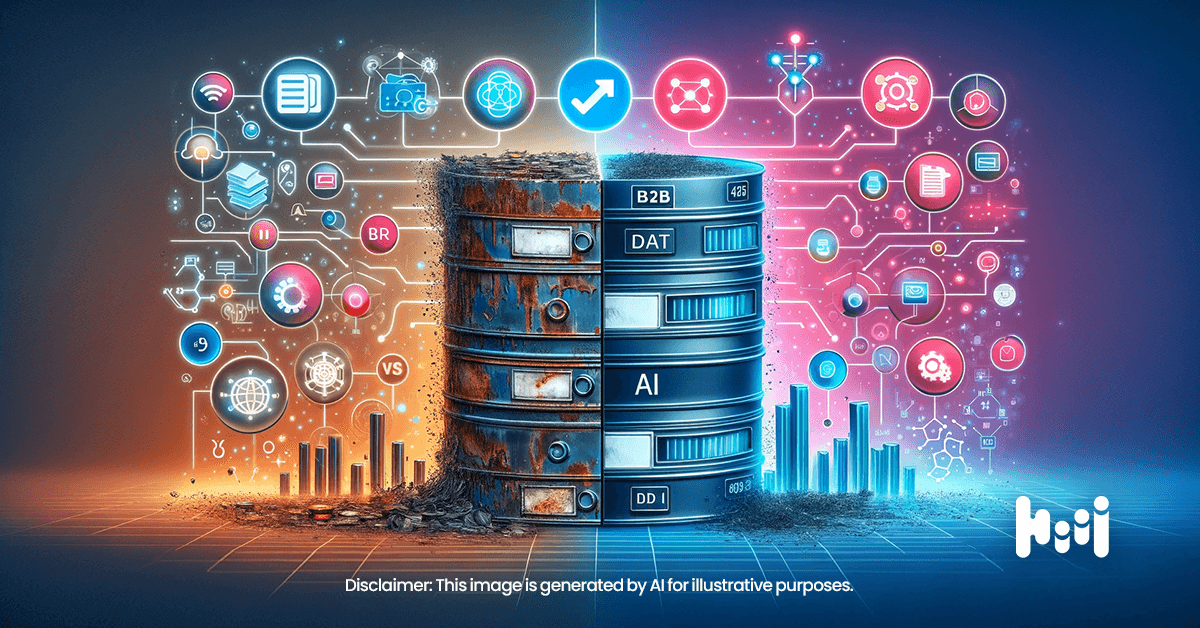According to the 2022 B2B Buyer Behavior Survey by Demand Gen Report, businesses are expanding their research horizons. With 31% allocating more time online, buyers are exploring diverse sources and collaborating with larger teams. Notably, online peer recommendations and ROI analyses (29%) are gaining influence. Web searches (51%), vendor websites (36%), and peer input (32%) remain pivotal. This data highlights the evolving digital landscape, emphasizing the importance of comprehensive online research in informed decision-making.
This means having information about your brand and how your service can help address pain points online is pivotal in attracting potential customers. However, once you have established what content information different audiences require from you and where they are in the sales funnel, what then?
You gear up to create quality B2B content and prepare to not just promote but disseminate them. This is where B2B content syndication comes in.
What is Content Syndication?
It is a method used by businesses to broaden their reach by republishing their content on third-party websites. This approach can significantly boost your brand’s visibility, drive traffic, and generate leads. This strategy is especially relevant in the B2B sphere, where the buying process is more prolonged, and prospective customers need multiple touchpoints before making a decision.
To understand B2B content syndication better, think of it as a reciprocal relationship. Your business creates high-quality, engaging content, and third-party websites republish it. These third-party sites benefit from your rich content, while your business gains exposure to a potentially larger and more diverse audience. A win-win situation that can significantly enhance your overall marketing strategy.
However, B2B content syndication is not a walk in the park. It requires careful planning, execution, monitoring, and assistance. This guide is designed to walk you through the process, from understanding the importance of B2B content syndication to identifying the most effective content types and best practices to implement them.
7 Content Types to Generate Quality Leads
Here’s a list of the most effective content types for B2B lead generation and where they can be most effectively used in your lead generation strategy.
1. Blogs
Blogs are a proven way to establish your brand as an industry expert. They are informative, engaging, and can delve into various topics, making them an ideal candidate for syndication.
Blogging is a cornerstone of content marketing for B2B. By consistently publishing high-quality blog posts, businesses can establish themselves as thought leaders and attract their target audience. This content type is usually consumed at the awareness stage, i.e., the top of the sales funnel. Prospects may either be looking for a solution or be simply bored at work, but if they come across a highly engaging and informative blog post, the chances of having them hooked will exponentially increase.
Implementation: When creating blog content, it is essential to focus on providing value and addressing the pain points of potential customers.
To maximize the impact of blog marketing, businesses should conduct thorough keyword research to identify relevant topics and optimize their content for search engine visibility. By incorporating targeted keywords naturally into these pieces of content, you can increase your chances of ranking higher in search engine results, driving more organic traffic to your website.
2. Infographics
In today’s fast-paced world, visual content has become increasingly popular. Infographics are a powerful way to present complex information in a visually appealing and easy-to-understand format. By condensing data, statistics, and key points into visually stimulating graphics, businesses can capture the attention of their target audience and deliver information in a concise and engaging manner. Infographics can be used to showcase industry trends, explain complex processes, or present data-driven insights.
Implementation: When creating infographics, you should focus on using eye-catching visuals, clear and concise messaging, and accurate data. By sharing infographics on social media, embedding them in blog posts, creating videos, and including them in email campaigns, you can maximize your reach and engagement.
3. Whitepapers
Whitepapers make for an incredible B2B content marketing tool. They are comprehensive and authoritative reports that delve deep into a specific industry topic or problem. They usually come in handy during the consideration stage, where prospects are now reviewing your brand and other alternatives to see which can best provide the solutions they seek. They provide in-depth analysis, research, and insights that can demonstrate your brand’s expertise and value proposition, positioning your business as a thought leader in the field.
Since whitepapers are typically longer than blog posts and require a more significant investment of time and resources, it is important to use these materials correctly so that they can guide your prospects further down the sales funnel.
Implementation: To create an effective whitepaper, businesses should start by identifying a topic that is relevant to their target audience. Additionally, businesses should ensure that this content also aligns with their expertise.
Businesses should conduct thorough research, gather data, and analyze industry trends. The whitepaper should present a unique perspective, offer actionable insights, and provide practical solutions to the challenges faced by businesses in the industry. Finally, promoting whitepapers through various channels such as email marketing, social media, and industry forums can help you generate leads as these mediums have wider reach for organic traffic.
4. Webinars
By the time your prospect reaches the consideration stage, they are already researching their options in terms of vendors and reviewing the solutions that each can provide. Webinars are a valuable content type for B2B businesses as they provide an interactive platform to connect with potential customers, showcase products or services, and address their pain points in real-time. Webinars allow you to engage with your audience and address the questions they may be harboring in the aforementioned consideration stage.
This is both content and platform that provides a dynamic and engaging way for your target audience to consume your content with your assistance. You can effectively communicate complex ideas and establish a more personal connection with your audience.
Implementation: When planning a webinar, B2B companies should identify a relevant topic that aligns with their target audience’s interests and pain points. You should develop a well-structured presentation, incorporating engaging visuals, compelling storytelling, and actionable insights. By promoting the webinar through email campaigns, social media, and industry partnerships, you can attract a larger audience, increase your attendance rate, and get high-quality leads.
5. Case Studies
Case studies target customers at the bottom of the funnel, in the purchase stage, making them perfect for a content syndication campaign.
At this time, they are developing shortlists to select between you and your competitors before making their purchase. Case studies are powerful tools that demonstrate how a business has successfully solved a problem or addressed a specific need for a client. They provide real-life examples of the value a business can deliver and help potential customers understand how they can benefit from the products or services offered.
Implementation: When creating a case study, businesses should focus on telling a compelling story that highlights the challenges faced by the client, the solutions provided, and the measurable results achieved. Including testimonials, data-driven insights, and visual elements can enhance the impact of the case study.
Case studies can be shared on the business website, included in email campaigns, and distributed through social media channels. By showcasing the success stories of satisfied clients, you are building trust, credibility, and confidence in your service.
6. Videos
Videos have become a dominant force in the digital content landscape, offering a compelling and engaging way for businesses to connect with their B2B audience. From product demonstrations to thought leadership interviews, videos provide a dynamic platform for showcasing expertise, sharing insights, and delivering impactful messages. They offer a visual and auditory experience that can effectively convey complex information in a format that is easy to consume and memorable.
Implementation: Leverage the power of video content by creating engaging and memorable experiences for your B2B audience. Humanize your brand, tell compelling stories, and showcase the value of your products or services. Driving meaningful connections and influencing purchasing decisions in each video content. Additionally, have these videos repurposed across various digital platforms, including websites, social media, and email marketing, maximizing their reach and potential impact.
7. Ebooks
Ebooks are comprehensive and valuable resources that offer in-depth insights, guides, and educational content to businesses seeking knowledge and solutions. They provide an opportunity for businesses to showcase their expertise, present thought leadership content, and offer practical solutions to complex challenges faced by their B2B audience. Ebooks serve as powerful lead magnets, capturing the attention of potential clients and guiding them towards engaging with the business further.
Implementation: Incorporating ebooks into the content marketing strategy allows businesses to create valuable touchpoints with potential clients, driving engagement and nurturing leads through the sales funnel. Address specific pain points and challenges within the industry and promote them through various channels, such as blogs, social media, and email marketing, amplifying their reach and influence.
You can even position these as valuable resources to targeted leads better by working with a content syndication platform or service. By leveraging the power of ebooks, you can maximize the undeniable impact of researching within the knowledge-voracious market.
Honorable Mention: Newsletters
Sending out newsletters allows businesses to stay connected with their audience. This is a way you can repurpose and distribute all content materials you have in your arsenal. It also supplements paid content syndication campaigns you might have ongoing.
Incorporating consistent newsletter campaigns to your overall B2B content marketing is a great way to nurture customer loyalty to your brand. By providing regular updates with the latest information about industry trends, you can boost customer loyalty without breaking the bank.
Implementation: When creating a newsletter, businesses should focus on delivering relevant and engaging content. They can include blog posts, industry news, case studies, success stories, and upcoming events. Before you distribute your content to any number of leads, remember that personalization is key to ensuring the newsletter resonates with the recipient. By segmenting your audience based on their interests and preferences, you can deliver targeted content that adds value to the recipient’s inbox.
Lastly, monitor and analyze newsletter performance. By analyzing open rates, click-through rates, and conversions, you can measure the effectiveness of your B2B content strategy and make data-driven improvements in the future.
Taking Your B2B Content Syndication to the Next Level
In conclusion, content plays an indispensable role in B2B marketing. It is the package that carries your brand’s message, values, and solutions to your target audience. And B2B content syndication is a potent strategy, acting as the package courier, that can take your content marketing to new heights.
By incorporating this variety of B2B content types into your content syndication approach, you are setting up your business to maximize success. Blog marketing, infographics, whitepapers, webinars, case studies, videos, and ebooks each play a unique role in attracting, engaging, and converting potential customers.
Remember, the key to successful B2B content syndication lies in understanding your buyer personas and creating content that resonates with them.
Demand Science can help you figure out and establish your ICPs. However, if you would want to know more about syndicating content, download this Demand Science Ultimate Guide to Content Syndication.











